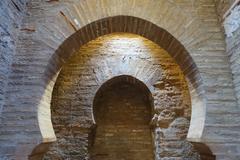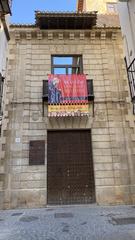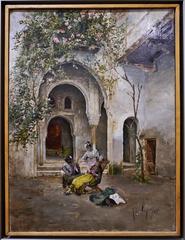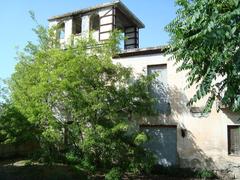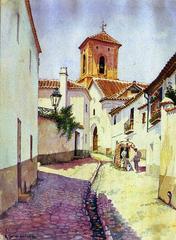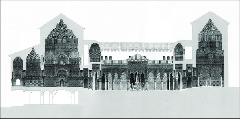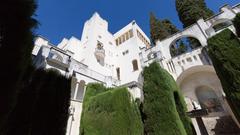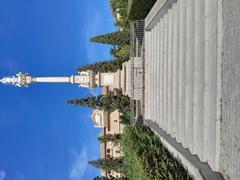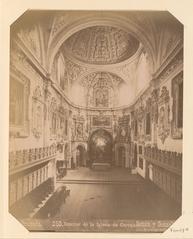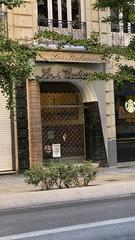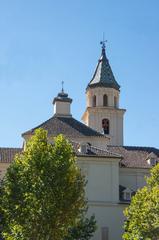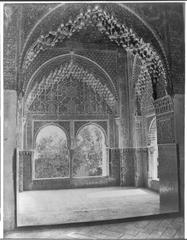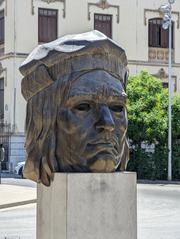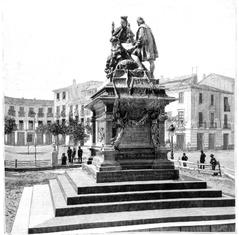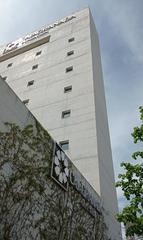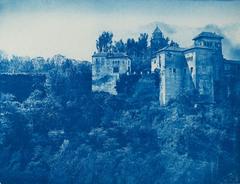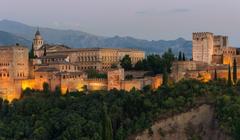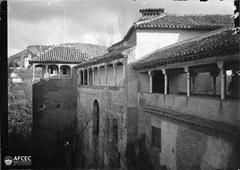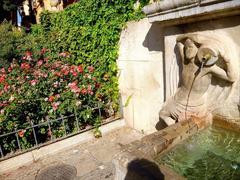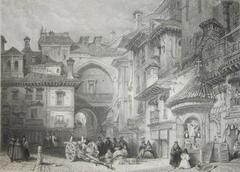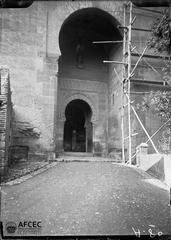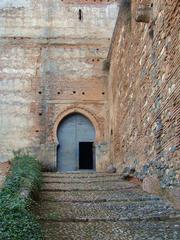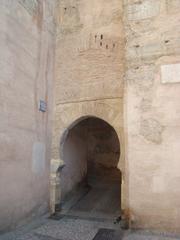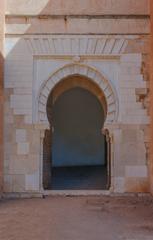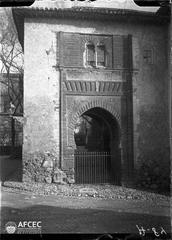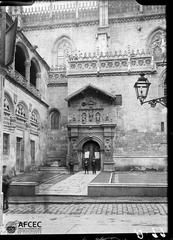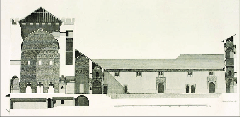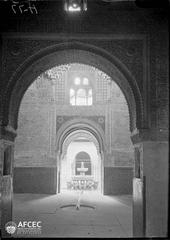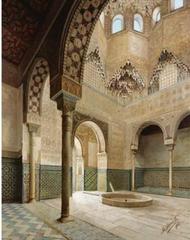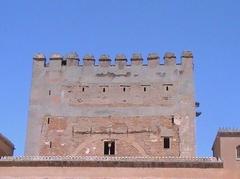Aljibe de la Lluvia, Granada, Spain – Visiting Hours, Tickets, and Historical Sites Guide
Date: 14/06/2025
Introduction
The Aljibe de la Lluvia stands as a unique testament to Granada’s centuries-old mastery of hydraulic engineering and urban water management. Set amid the scenic landscapes of the Dehesa del Generalife, this cistern, originating as early as the 10th century, played a crucial role in supplying water to both palatial complexes and local communities. Today, it remains a symbol of the city’s multicultural heritage and the enduring ingenuity of al-Andalus (Lugares de Granada). This detailed guide provides essential information on the Aljibe’s visiting hours, ticketing, accessibility, historical context, and nearby attractions to help you plan a memorable visit.
Table of Contents
- Introduction
- Historical Overview
- Architecture and Engineering
- Cultural and Urban Significance
- Conservation and Accessibility
- Visitor Information
- Activities and Nearby Attractions
- Practical Tips and FAQs
- Visuals and Media
- Summary and Travel Recommendations
- References
Historical Overview
Origins and Purpose
The Aljibe de la Lluvia (Rain Cistern) is a prime example of early medieval hydraulic engineering in Granada, with origins believed to date back to the 10th century during the Caliphate era. Its construction is mentioned in chronicles by historian Ibn Asim, a contemporary of Almanzor (Lugares de Granada). Strategically placed on the Cerro del Sol, within today’s Dehesa del Generalife, the cistern was designed to collect and store rainwater—a vital resource in Granada’s semi-arid climate. It primarily supplied the palatial complex of Dar al-Arusa, supporting both its daily needs and lush gardens (Andalucia 360 Travel).
Historical Evolution
The cistern formed part of a larger network of hydraulic structures, including the Acequia del Rey and other reservoirs like Alberca Rota and Albercón del Negro. These systems, developed during Islamic rule, continued to function and evolve through the Christian Reconquista and into modern times. The Aljibe’s robust design and strategic location also made it a resource for travelers, livestock, and later even for firefighting (Granada Historical Sites Guide).
Architecture and Engineering
Structure and Materials
Constructed primarily of brick and lime mortar, the Aljibe de la Lluvia is largely subterranean, with a square plan measuring approximately 7.7 meters per side. Its vaulted roof is supported by a central pillar, dividing the interior into four naves with barrel vaults and pointed arches (Lugares de Granada). The design maintains a cool temperature, preserves water quality, and prevents evaporation. The walls were lined with waterproof mortar, a hallmark of Andalusian cistern construction.
Water Collection System
Rainwater was funneled into the cistern through a central opening in the roof, supplemented by additional inlets and an overflow channel. Filters at entry points ensured the purity of the stored water. Access was provided via a stairway, though public entry is now restricted to preserve the structure (Andalucia 360 Travel).
Cultural and Urban Significance
The Aljibe de la Lluvia was more than a utilitarian reservoir; it was a social hub and a symbol of communal resource management. Historical accounts describe it as a gathering place for residents and travelers, and local traditions blend Islamic and Christian narratives around its origins. The cistern’s continued presence is a living reminder of Granada’s multicultural past, bridging Roman, Islamic, and Christian eras (Rincones de Granada).
Conservation and Accessibility
Recent restoration efforts have stabilized the Aljibe’s structure, repaired masonry, and improved drainage to ensure its longevity (Granada Historical Sites Guide). While the exterior and immediate surroundings are accessible, entry to the interior is generally restricted to protect the delicate structure.
Visitor Information
Location and Access
The Aljibe de la Lluvia is located within the Dehesa del Generalife, above the Alhambra and Generalife palaces. Access is via the Camino del Llano de la Perdiz, starting near the Granada cemetery (Cementerio de San José). The forest track is suitable for most vehicles, though it is unpaved and may be uneven (Milyunarutas).
GPS coordinates: 37.1765, -3.5703
Parking: A designated parking area is available adjacent to the recreational zone.
Visiting Hours
- The site is open year-round during daylight hours.
- There are no formal entrance gates or closure times, but it is safest and most enjoyable to visit during the day (Rincones de Granada).
Tickets and Admission
- Free entry: There is no ticket required to visit the Aljibe de la Lluvia or the surrounding area.
- Interior access: The cistern itself is not open to the public except on rare occasions, such as guided heritage tours.
Facilities and Amenities
- Parking: Marked area next to the site.
- Picnic tables: Two tables for public use.
- Barbecue: One barbecue, usable only outside wildfire season (June 1 to October 30: all fires prohibited).
- Water: No potable water available; do not drink from the cistern (Junta de Andalucía).
- Restrooms: None on-site.
- Waste disposal: No bins; take your rubbish with you.
Accessibility
- The approach is a dirt track, not suitable for large vehicles or those with low clearance.
- Wheelchair access is limited due to unpaved paths and uneven terrain.
- The cistern can be seen from the outside, but there are steps down to the entrance that are generally closed off (Rincones de Granada).
Safety and Regulations
- Fires: Use only the designated barbecue outside fire season and if permitted.
- Water: Untreated; not for drinking or recreational use.
- Wildlife: Do not disturb animals or plants.
- Vehicles: Stay on marked tracks; do not drive off-road.
- Mobile coverage: May be unreliable; let someone know your plans.
Activities and Nearby Attractions
Hiking and Nature
The Dehesa del Generalife offers several marked trails ideal for hiking and mountain biking. The Acequia Real Dehesa del Generalife trail and the loops covering Valle del Oro, Llano de la Perdiz, and the Silla del Moro are popular choices, offering views of Granada and the Sierra Nevada (Junta de Andalucía).
Historical and Cultural Sites
- Alhambra and Generalife: World-renowned palaces and gardens just below the park.
- Silla del Moro (Castillo de Santa Elena): A nearby hilltop fortress with panoramic views.
- Dar al-Arusa and Alberca Rota: Ruins of Nasrid royal retreats and water reservoirs.
- Albaicín and Sacromonte: Historic neighborhoods known for Moorish architecture and flamenco traditions.
Area History
Adjacent to the Aljibe is a 19th-century alberca, constructed during Granada’s gold rush, which adds an industrial archaeology aspect to the visit (Milyunarutas).
Practical Tips and FAQs
- Best time to visit: Spring and autumn for mild weather; summer can be hot, and shade is limited to the picnic area.
- Supplies: Bring water, snacks, sun protection, and rubbish bags.
- Footwear: Wear sturdy shoes for uneven terrain.
- Pets: Allowed but must be controlled.
Frequently Asked Questions
Q: Is there an entrance fee or ticket required?
A: No, the site is free to visit.
Q: What are the visiting hours?
A: Open during daylight hours year-round.
Q: Is it wheelchair accessible?
A: Access is limited due to uneven, unpaved terrain.
Q: Can I drink from the aljibe?
A: No, the water is untreated and not safe for consumption.
Q: Are guided tours available?
A: Occasionally, through local organizations; check with the Junta de Andalucía visitor portal.
Q: Are pets permitted?
A: Yes, but keep them under control to protect wildlife.
Visuals and Media
Summary and Travel Recommendations
The Aljibe de la Lluvia offers visitors a direct connection to Granada’s medieval past and a powerful example of sustainable water management. Its setting within the Dehesa del Generalife park allows for a blend of historical exploration, hiking, and immersion in nature. Whether you visit as part of a hiking excursion, a cultural tour of Granada’s palatial complexes, or a family picnic, the Aljibe provides a memorable experience steeped in the city’s layered history (Granada Historical Sites Guide; Lugares de Granada; Andalucia 360 Travel; Rincones de Granada).
For a richer visit, consider joining a guided tour or using the Audiala app for interactive maps and audio commentary. Combine the Aljibe experience with nearby sites such as the Alhambra, Silla del Moro, and the Albaicín for a comprehensive journey through Granada’s architectural and cultural heritage.
References
- Granada Historical Sites Guide
- Lugares de Granada
- Andalucia 360 Travel
- Rincones de Granada
- Milyunarutas
- Junta de Andalucía

